WAF-1
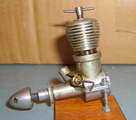 |
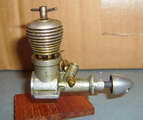 |
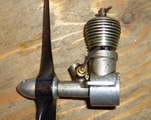 |
Click on images to view larger picture.
The WAF-1 was made by Walter A Frisch of Berlin-Lubars. Production began in 1951 and continued for about five years. The WAF-1 was a "long stroke" design with a bore of 10.2mm and stroke of 12mm for a nominal displacement of 1cc (0.98 if we're being pedantic). It was reviewed favourably and anonymously in British magazine, Model Aircraft (MA), of December 1953.
 |
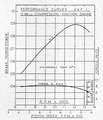 |
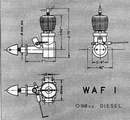 |
The cut-away drawing from the MA review shows the cylinder porting arrangement which was quite "advanced" for the time. Quite unusual are the small, squared exhaust ports (spend a moment thinking how you might go about producing these rather tiny openings with precision, in quantity? A rather small diameter key-way cutter has been about all I can come up with). The transfer ports employ inclined passages exiting in the substantial inter-port posts—a scheme that is similar to that which has become known as Oliver Porting. The cylinder liner screws into the crankcase casting using a thread on the flange. The lower section of the liner is smaller in diameter than the opening in the crankcase, providing an annular transfer passage to the ports. The remainder of the design is quite conventional with the possible exception of the spray bar that angles the needle valve rearwards and upwards for operator convenience, but prevents the assembly being reversed as would be required for inverted mounting in a control line model.
Peter Chinn's International Engine Review published in Model Aircraft for April, 1955 includes two WAF engines in the table on page 141. In addition to the WAF-1, he lists a "WAF 5cc" giving the bore as 0.7165 (18.2mm) and stroke of 0.7480 (19mm) for a displacement of 4.93cc. The engine is not mentioned in the text, and while the heading photo for the article shows what is clearly a WAF engine, it is probably the WAF-1. But Chinn is usually reliable, so we can be reasonably sure that at least one 5cc WAF existed.
Although made in quantity, the 1cc engine is relatively rare outside Europe. If you come into possession of one, don't be tempted to straighten the apparently bent "tommy-bar", this is factory standard! The intent being to prevent ambiguity in relation to the position of the compression screw.
 Indications are that Herr Frisch liked to experiment. This photo from Tim Dannels' ECJ files shows a double-ended WAF-1, geared for torque-cancelling but turning-couple inducing contra-rotation. Engines fitted with backplate mounted vacuum pumps are also known to exist—this being a popular means of driving control surface actuators for radio control in West Germany during the 1950's and early 60's. In addition to the 1cc model, Frisch produced an experimental 3.5cc engine, essentially a scaled up WAF-1, which never entered production.
Indications are that Herr Frisch liked to experiment. This photo from Tim Dannels' ECJ files shows a double-ended WAF-1, geared for torque-cancelling but turning-couple inducing contra-rotation. Engines fitted with backplate mounted vacuum pumps are also known to exist—this being a popular means of driving control surface actuators for radio control in West Germany during the 1950's and early 60's. In addition to the 1cc model, Frisch produced an experimental 3.5cc engine, essentially a scaled up WAF-1, which never entered production.
Thanks go to Lennart Ljungberg and Tim Dannels for the pictures.